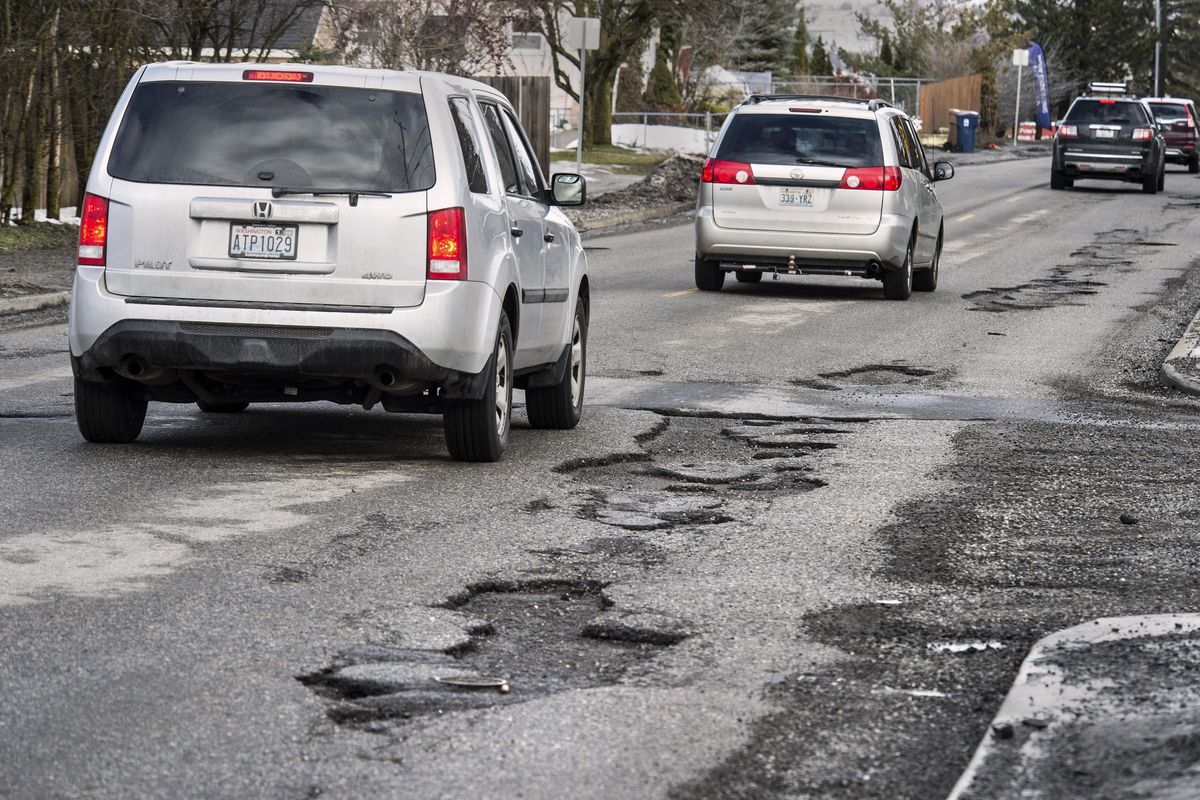Bigger crews, new equipment and materials called in to combat Spokane’s potholes

Wastewater and sewer workers will join street crews fighting Spokane’s massive pothole outbreak, and an asphalt plant will open a month early to provide the city with hot material to patch the pockmarks, Mayor David Condon said Friday.
“Our citizens have really deserved the extra effort,” Condon said at a City Hall news conference Friday morning.
Crews have filled in roughly 1,300 potholes since the beginning of the year, Condon said, about a third of the total repaired in all of 2016. Alongside Gary Kaesemeyer, the city’s new streets director, and Scott Simmons, public works director, Condon said the plan to address remaining and emerging potholes involved more people, new techniques and financial backing from the Spokane City Council.
Councilwoman Amber Waldref, chair of the city’s Public Works Committee, said she expects the council to increase the budget to boost pothole repairs.
Inland Asphalt, a local plant that sells material to the city of Spokane, will open the week of March 6 to begin supplying crews with hot-mix material that is a more long-term solution than the cold patching that’s been applied this winter. Kaesemeyer said the city will test bridge-decking material to fill holes in the meantime, which is harder than the traditional filler. The city also will bring in new equipment that has been successful in Idaho and Oregon in areas where traditional filling methods have failed, he said.
“We’re going to see if that’s more cost-effective, in the long run,” Kaesemeyer said.
Kaesemeyer, who was appointed to replace Streets Director Mark Serbousek from his position as superintendent of wastewater collection and maintenance, said he had little to do with combining the efforts of that department and street workers to address the pothole problem.
“They are doing the same tasks that the street guys are doing, just repairing the potholes,” Kaesemeyer said. “What’s helpful, is they are bringing additional equipment.”
Street crews can bring vacuum trucks and compressors to assist in drying the holes before they’re filled, said Marlene Feist, director of strategic development for the public works and utilities department.
Joe Cavanaugh, president of union Local 270 that represents city laborers in both departments, said it’s not unusual for crews to combine efforts in what he called “emergency” situations.
But it’s the first time Cavanaugh said he can remember that type of collaboration to address potholes.
“We’re in new times,” he said.
Crews are authorized to work 20-hour days during the winter, Condon said, and any work performed by utility crews will be billed to the city’s streets department and transferred later this year upon approval by the City Council.
Condon stopped short of declaring an emergency for the potholes, he said, because of the high threshold that needed to be met for state and federal dollars. He also said the issue isn’t one of funding but of effectively allocating resources, noting that voters approved an extension of the street bond in 2014 to pay for road construction and maintenance.
Simmons said the administration is hearing from the public that there is “a sense of urgency” to address the potholes.
Condon encouraged citizens to continue to report potholes online, allowing the city to gather data about where the trouble spots are and potentially revise maintenance plans. Waldref said the complaints about the condition of Freya Street, and the complaints the city has received this winter, may push that project higher on the list of street repair priorities over the next six years.
The north-south arterial is scheduled for crack seal replacement in 2017, according to the city’s streets plan, part of what is expected to be the city’s largest year of street construction ever, according to the administration. Several of the claims filed with the city this month for pothole damage, including 15 during a one-week period, mentioned concerns about the condition of Freya.
Condon said the city is considering what type of material they will use on Freya in the future, pointing to the success of a concrete-based material on the Monroe Street hill that has seen significantly fewer potholes, despite the hilly terrain and pooling of collected stormwater.
“Is it a material change in that area that works better? Is it linking it to our stormwater system to divert the water from that area? That’s why looking at things – holistically, not just curb to curb – is a better way of addressing this,” Condon said.